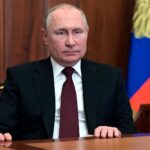
After several rounds of peace negotiations between Russia and Ukraine, Russia has begun to state explicitly (via foreign ministry spokesperson Maria Zakharova) that its war aims do not include overthrowing the elected government of Ukrainian President Volodymyr Zelensky or occupying the country.
Welcome to Vladimir Putin’s Plan B.
When Russia’s invasion of Ukraine began two weeks ago, overthrowing its government and installing a Russian-friendly puppet regime was very much the goal. But Putin’s Plan A hasn’t worked out as hoped. The Ukrainian military has fought back harder than anticipated. Zelensky has become a hero admired across the country and throughout the democratic world. And Russia’s military has suffered severe setbacks. Add in economic sanctions imposed by Western governments (and boycotts by a long list of companies) that are far harsher than Putin, or really anyone, expected, and we’re left with something approaching a debacle for the Russian autocrat.
Of course Putin can’t just end his Ukrainian misadventure, slinking back across the border empty-handed. He needs to be able to point to some alteration in the pre-invasion status quo to justify Russia’s enormous loss of blood and treasure, and to protect himself against a palace coup.
That’s how we get to Plan B, which my colleague Grayson Quay summarized in a recent column: Ukraine would “formally cede Crimea to Russia, recognize the independence of the Russian-backed separatist republics in eastern Ukraine, and amend the Ukrainian constitution to forbid membership in international blocs like NATO and the European Union.” Then there’s Wednesday’s clarification that Zelensky’s government would get to remain in power.
This would turn Ukraine into a neutral zone between NATO and Russia. That would be a significant break from the way things worked during Cold War 1.0, when lines of separation between west and east were sharp and clear. Back then, you were either on one side of the Iron Curtain or the other — West Germany or East Germany, Paris or Prague. We can already see that stark division returning to borders today, only somewhat further east: between the Baltic states and northern Russia, between Poland and Belarus. If Putin had gotten his way in Ukraine, with a puppet regime installed in Kyiv, the dividing line would have been pushed to Ukraine’s western border with Moldova and the NATO states of Poland, Slovakia, Hungary, and Romania.
But that now looks beyond Putin’s grasp. Hence the fallback of turning Ukraine into an 800-mile-wide DMZ between west and east.
Whether Putin will demand literal or only figurative demilitarization remains to be seen, as does Zelensky’s willingness to accept whatever the Kremlin ultimately demands. Even more significant is the question of whether the U.S. and NATO will accept it. (Hard lines can be easier to defend than blurred ones.)
We may receive answers sooner than any of us expected.
You may also like
Why Poland hasn’t given Ukraine its MiG-29 fighter jets to combat Russia despite U.S. ‘green light’
Kremlin publishes list of countries it has deemed ‘unfriendly’ toward Russia
How cheap Chinese tires might explain Russia’s ‘stalled’ 40-mile-long military convoy in Ukraine




